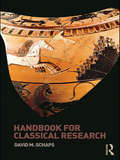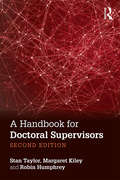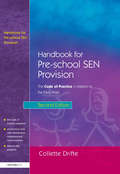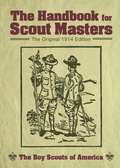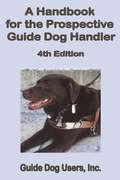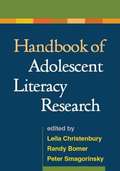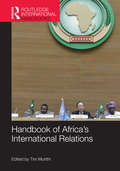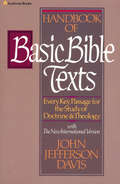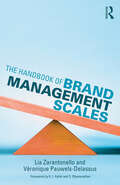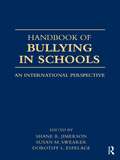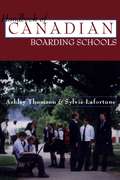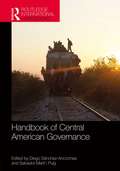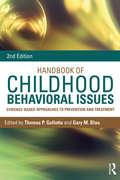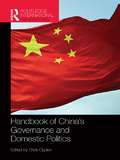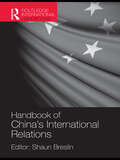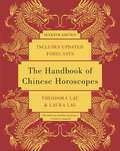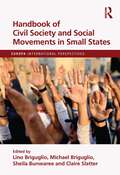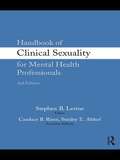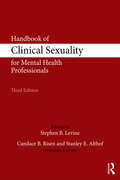- Table View
- List View
Handbook for Classical Research
by David M. SchapsOne of the glories of the Greco-Roman classics is the opportunity that they give us to consider a great culture in its entirety; but our ability to do that depends on our ability to work comfortably with very varied fields of scholarship. The Handbook for Classical Research offers guidance to students needing to learn more about the different fields and subfields of classical research, and its methods and resources. The book is divided into 7 parts: The Basics, Language, The Traditional Fields, The Physical Remains, The Written Word, The Classics and Related Disciplines, The Classics since Antiquity. Topics covered range from history and literature, lexicography and linguistics, epigraphy and palaeography, to archaeology and numismatics, and the study and reception of the classics. Guidance is given not only to read, for example, an archaeological or papyrological report, but also on how to find such sources when they are relevant to research. Concentrating on "how-to" topics, the Handbook for Classical Research is a much needed resource for both teachers and students.
A Handbook for Doctoral Supervisors
by Stan Taylor Margaret Kiley Robin HumphreyAcross the globe, doctoral education is in the throes of change. Diversification, regulation and proliferation are just a few of the developments that pose major challenges for those supervising doctoral candidates. The second edition of A Handbook for Doctoral Supervisors has been fully updated to assist doctoral supervi
Handbook for Itinerant and Resource Teachers of Blind and Visually Impaired Students
by Doris Willoughby Sharon DuffyProvides suggestions for teachers of the visually impaired
Handbook for Pre-School SEN Provision: The Code of Practice in Relation to the Early Years
by Chris Spencer Kate SchnellingDesigned specifically for those involved in pre-school education, including nursery teachers, learning support assistants and helpers in a range of provisions, this handbook has been updated to enable carers to comply with the latest requirements of the Code of Practice and to prepare for an OFSTED inspection. It will assist in the identification and assessment of young children with special educational needs. The book provides a ready-made system for record keeping at each stage of assessment and provides a comprehensive system for monitoring and evaluation.
The Handbook for Scout Masters: The Original 1914 Edition
by The Boy Scouts of AmericaNow Available Again, the Original 1914 Rules, Regulations, and Lessons Necessary for Boy Scout Leaders First published in 1914, the Handbook for Scout Masters was the foremost compendium on leading and guiding a Boy Scout troop. Here, word for word, you can read all about just what it took to be a Scout Master, with a focus on the boys themselves. After all, the Boy Scouts&’ main purpose was &“not to exploit methods, not glorify movements . . . but to lead boys into useful lives&” (from the Introduction). Chapters from this classic, standard handbook include: Scout RequirementsPrinciples and MethodsTroop and Patrol ManagementDrills and DemonstrationsChivalry and MoralityAnd more! From age limits, hierarchies, and oaths to lessons on cooking, first aid, and nature, The Handbook for Scout Masters covers all the basics of what it took to lead a Boy Scout troop. Scouts and scout masters alike will love reading about the original guidelines to one of America&’s most well-known youth organizations.
Handbook for Shell Collectors,Revised Edition
by Walter Freeman WebbDescriptions of over 2000 marine species.
A Handbook for Teaching Assistants: Teachers and assistants working together
by Glenys FoxThis revised new edition provides essential guidance for all teaching assistants, especially those who are new to the job, and to the teachers working with them. Glenys Fox details the roles and responsibilities of the TA, as well as providing helpful advice on how to best support the teacher, the pupil, the curriculum and the school. This practical handbook will bring experienced TAs up to date on changes to National educational guidance, including changes in the National Curriculum, assessment, and the Special Educational Needs framework. This text enables the assistant and the teacher to work together more effectively in supporting and promoting the progress of children and young people. Written in light of recent research and updates in legislation, this guide will ensure that: teaching assistants know what to expect of colleagues, and vice versa pupils are given the best possible support by teaching assistants who understand their needs teaching assistants and teachers are able to work together effectively to support the learning of all children, especially children who have special educational needs and disabilities any training received is relevant and helpful. A Handbook for Teaching Assistants is an ideal textbook for training, as well as a useful classroom handbook for teaching assistants working in early years, primary and secondary settings.
A Handbook for the Prospective Guide Dog Handler
by Guide Dog Users Inc.A handbook full of information for those considering getting a guide dog.
A Handbook of Abbreviations
by Portrait AdvertisingGiven in this book are some of the commonly used abbreviations with particular reference to those used in the Indian context.
Handbook of Adolescent Literacy Research
by Leila Christenbury Randy BomerThe first comprehensive research handbook of its kind, this volume showcases innovative approaches to understanding adolescent literacy learning in a variety of settings. Distinguished contributors examine how well adolescents are served by current instructional practices and highlight ways to translate research findings more effectively into sound teaching and policymaking. The book explores social and cultural factors in adolescents' approach to communication and response to instruction, and sections address literacy both in and out of schools, including literacy expectations in the contemporary workplace. Detailed attention is given to issues of diversity and individual differences among learners.
Handbook of Africa's International Relations (Routledge International Handbooks Ser.)
by Tim MurithiAfrica’s international relations have often been defined and oriented by the dominant international and geopolitical agendas of the day. In the aftermath of colonialism the Cold War became a dominant paradigm that defined the nature of the continent’s relationship with the rest of the world. The contemporary forces of globalization are now exerting an undue influence and impact upon Africa’s international relations. Increasingly, the African continent is emerging as a vocal, and in some respects an influential, actor in international relations. There is a paucity of analysis and research on this emerging trend. This timely book proposes to fill this analytical gap by engaging with a wide range of issues, with chapters written by experts on a variety of themes. The emerging political prominence of the African continent on the world stage is predicated on an evolving internal process of continental integration. In particular, there are normative and policy efforts to revive the spirit of Pan-Africanism: the 21st century is witnessing the evolution of Pan-Africanism, notably through the constitution and establishment of the African Union (AU). Given the fact that there is a dearth of analysis on this phenomemon, this volume will also interrogate the notion of Pan-Africanism through various lenses – notably peace and security, development, the environment and trade. The volume will also engage with the emerging role of the AU as an international actor, e.g. with regard to its role in the reform of the United Nations Security Council, climate change, the International Criminal Court (ICC), the treaty establishing Africa as a nuclear-free zone, Internally Displaced Persons, the Millennium Development Goals (MDGs), international trade, the environment, public health issues, security, and development issues. This book will assess how the AU’s role as an international actor is complicated by the difficulty of promoting consensus among African states and then maintaining that consensus in the face of often divergent national interests. This book will in part assess the role of the AU in articulating collective and joint policies and in making interventions in international decision and policy-making circles. The Handbook will also assess the role of African social movements and their relationship with global actors. The role of African citizens in ameliorating their own conditions is often underplayed in the international relations discourse, and this volume will seek to redress this oversight. Throughout the book the various chapters will also assess the role that these citizen linkages have contributed towards continental integration and in confronting the challenges of globalization.
Handbook of Basic Bible Texts: Every Key Passage for the Study of Doctrine and Theology
by John Jefferson DavisThis volume provides the complete text of key Scripture passages that form the basis for theological study. The text used is the highly readable and modern New International Version. The verses listed are grouped by the classical categories of systematic theology (e.g., God, Christ, Salvation); on disputed points, verses from which the major theological views derive are given. Footnotes provide clarification and brief commentary on verses as appropriate. This work is intended to assist the theological student who might not take the time to look up the verses cited in systematic theologies, but it will also be useful to anyone seeking to better understand the major themes of Scripture.
A Handbook of Biological Investigation (Seventh Edition)
by Harrison W. Ambrose Katharine Peckham Ambrose Douglas J. Emlen Kerry L. BrightThis book is written as a reference aid to be used by biology students at any time they are first exposed to the scientific method and to original research. It guides the beginner through elementary experimental design, data collection and analysis, and the subsequent writing of a scientific report. In addition, it provides an introduction to the literature of biology and a basic search strategy for finding relevant, published information in a library.
The Handbook of Brand Management Scales
by Lia Zarantonello Véronique Pauwels-DelassusThe Handbook of Brand Management Scales is a concise, clear and easy-to-use collection of scales in brand management. Scales are a critical tool for researchers measuring consumer insights, emotions and responses. Existing handbooks of marketing scales do not include (or include very few) scales related to brand management constructs. This book is the first to meet this need. Sample scales include brand personality, brand authenticity, consumer–brand relationships and brand equity. Each scale is included with a clear definition of the construct it is designed to benchmark, a description of the scale itself, how to use it and examples of possible applications in managerial and academic contexts. A much-needed reference point, this is a unique, vital and convenient volume that should be within reach of every marketing scholar's and manager's desk.
Handbook of Bullying in Schools: An International Perspective
by Shane R. Jimerson Dorothy L. Espelage Susan M. SwearerThe Handbook of Bullying in Schools provides a comprehensive review and analysis of what is known about the worldwide bullying phenomena. It is the first volume to systematically review and integrate what is known about how cultural and regional issues affect bullying behaviour and its prevention. Key features include the following: Comprehensive – forty-one chapters bring together conceptual, methodological, and preventive findings from this loosely coupled field of study, thereby providing a long-needed centerpiece around which the field can continue to grow in an organized and interdisciplinary manner. International Focus – approximately forty-percent of the chapters deal with bullying assessment, prevention, and intervention efforts outside the USA. Chapter Structure – to provide continuity, chapter authors follow a common chapter structure: overview, conceptual foundations, specific issues or programs, and a review of current research and future research needs. Implications for Practice – a critical component of each chapter is a summary table outlining practical applications of the foregoing research. Expertise – the editors and contributors include leading researchers, teachers, and authors in the bullying field, most of whom are deeply connected to organizations studying bullying around the world.
The Handbook of Canadian Boarding Schools
by Ashley Thomson Sylvie LafortunePrivate schools have frequently provided innovative, experimental, and creative programunavailable to students in the public system. The most successful have survived and expanded by offering an educational experience widely perceived to be not just as good as that available in the public system, but better. In Canada, private schools are enjoying an unprecedented popularity and while most are day-only, over sixty sustain boarding programs, as do two off-shore Canadian schools. The Handbook of Canadian Boarding Schools presents information on the educational environment of each province,then offers comparative information on each boarding school. The information on each school includes: basic data, location, history, philosophy, the campus, boarding facilities, health and safety, administration and faculty, student body and student conduct, academic calendar and program, information technology, student activities and student conduct, admission and costs. The Handbook also supplies several appendices outlining important programs often available through boarding schools, such as Advanced Placement courses and the International Baccalaureate. For parents in Canada and abroad about to commit substantial sums to their children’s education, the Handbook of Canadian Boarding Schools is an essential tool to help them make the right decision. It is also an indispensable resource for supporters of the public system looking for ideas that have worked elsewhere.
Handbook of Central American Governance
by Diego Sánchez-Ancochea and Salvador Martí i PuigCentral America constitutes a fascinating case study of the challenges, opportunities and characteristics of the process of transformation in today’s global economy. Comprised of a politically diverse range of societies, this region has long been of interest to students of economic development and political change. The Handbook of Central American Governance aims to describe and explain the manifold processes that are taking place in Central America that are altering patterns of social, political and economic governance, with particular focus on the impact of globalization and democratization. Containing sections on topics such as state and democracy, key political and social actors, inequality and social policy and international relations, in addition to in-depth studies on five key countries (Costa Rica, Nicaragua, El Salvador, Honduras and Guatemala), this text is composed of contributions from some of the leading scholars in the field. No other single volume studies the current characteristics of the region from a political, economic and social perspective or reviews recent research in such detail. As such, this handbook is of value to academics, students and researchers as well as to policy-makers and those with an interest in governance and political processes.
Handbook of Childhood Behavioral Issues: Evidence-Based Approaches to Prevention and Treatment
by Thomas P. Gullotta Gary M. BlauThis handbook highlights present-day information and evidence-based knowledge in the field of children’s behavioral health to enable practitioners, families, and others to choose and implement one of many intervention approaches provided. Using a standardized format, best practices for the prevention and treatment of many childhood behavioral disorders are identified based on current research, sound theory, and behavioral trial studies. This revision includes an integration of the DSM-5 diagnostic manual and new chapters on childhood psychosis and military families, and a thorough updating of the research in the previous edition.
Handbook of China’s Governance and Domestic Politics (Routledge International Handbooks Ser.)
by Chris OgdenThis Handbook provides an in-depth overview of how China is governed, how its domestic political system functions and the critical issues that it currently faces. Governed by the world’s largest political party in the world’s longest-ruling Communist regime, China is undergoing a transitional period of rapid economic and social development. How this period is managed will have significant implications for the Chinese state and its population concerning China’s governance structures and economy, as well as the country’s justice, public health, education and internal/external security concerns. This transition to a modern state is not without its challenges – particularly in terms of how the Chinese state deals with diverse issues such as social inequality, corruption, separatism, increasing individualism and political reform. China’s governance and domestic politics also have possible major global consequences, especially in the context of China's continued rise within the international system. This Handbook will improve understandings of the core national dynamics of this rise and, as levels of international interdependence with China increase, can offer vital insights concerning China's domestic attributes. Gaining a better knowledge of China's internal workings can also help better appreciate the multiple and varied problems that China’s leaders will face in the coming decades. Critically, many of the core internal issues facing China also have potential external repercussions, principally in terms of rising social unrest, nationalism, environmental degradation, resource shortages and attitudes towards globalization. This book aims to cover these issues and will help readers to fully comprehend China’s ongoing contemporary global significance.
A Handbook of China's International Relations (Routledge International Handbooks Ser.)
by Shaun BreslinThis Handbook, comprising around twenty-five chapters provided by numerous experts in the field, will prove invaluable to students of international affairs, academics, researchers, businesspeople and policy analysts. Chapters will give up-do-date and unbiased information on the current state of Chinese international relations in historical perspective.
The Handbook of Chinese Horoscopes 7e
by Theodora Lau Laura LauDo you know which of the twelve animal signs you are and how "the animal that hides in your heart" influences your outlook on life and your relationships with others? Learn how the five elements, four seasons, and the ascendant sign based on hour of birth can affect your personality. Find out what happens in your chart when Eastern moon sign meets Western sun sign, and discover the 144 marriage combinations to see the relationships between the twelve lunar signs. Look to the future and learn how you are likely to fare in the upcoming years.
Handbook of Civil Society and Social Movements in Small States (Europa International Perspectives)
by Lino Briguglio Claire Slatter Michael Briguglio Sheila BunwareeThis volume is unique because of its focus on small states. There are many studies on civil society and social movements, but none that specifically deal with this category of countries. As is well known, small states have particular characteristics, including a limited ability to reap the benefits of economies of scale, a high degree of exposure to forces outside their control, and the proximity of politicians to the voters, often leading to clientelistic relationships and patronage networks. The small island developing states have the additional problem of high environmental vulnerability, with some also dealing with disproportionate ecological footprints. These factors have a bearing on the organization and performance of civil society organizations and social movements, as explained in several chapters of this book. The volume is organized in three parts, dealing with aspects of civil society and social moments in small states in the political, social and environmental spheres, respectively. Various definitions of civil society are proposed in the chapters, but most authors associate the term with organized groups, operating in the interest of citizens, independently of government and commercial business, including various forms of non-governmental organizations (NGOs). Civil society also encompasses social movements, which are considered to be loosely organized collective campaigns in pursuit of social goals. These two terms are sometimes used interchangeably; however, some authors argue that social movements tend to engage in ‘contentious politics’ including protests, while NGOs engage through more organized and institutional routes.
Handbook of Clinical Sexuality for Mental Health Professionals
by Candace B. Risen Stanley E. Althof Stephen LevineThe constantly-changing field inspired the second edition of Handbook of Clinical Sexuality for Mental Health Professionals. In a state-of-the-art guide, Dr. Levine and his associates continue to help professionals with the assessment and treatment of a large array of sexual concerns. Written in a personal, supervisory style, the book will help new therapists anticipate clinical contingencies and help experienced therapists refine their thinking and teaching. Easily accessible, the Handbook is divided into six major sections with helpful annotated references: Being a Therapist; Intimacy; Sexual Dysfunction; Sexual Identity Struggles; The Forgotten; and Additional Vital Topics. Twenty-one chapters have been thoroughly revised and updated, and five new ones have been added. These focus on gay and lesbian life, transitioning to single life, cancer survivorship, the sexual issues of the developmentally challenged, and sex among the aging.
Handbook of Clinical Sexuality for Mental Health Professionals (500 Tips Ser.)
by Candace B. Risen Stanley E. Althof Stephen B. LevineThe Handbook of Clinical Sexuality for Mental Health Professionals, 3rd Edition, builds on the authors’ authoritative first person voice on sexual matters of the previous editions. The work reflects the field's growing sophistication about sexual disorders and their therapies. The scope has been expanded to keep pace with new literature and research in the field, and eight additional chapters have been added. New topics include the politics of diagnosis, persistent genital arousal, asexuality, post orgasm illness, scientific findings concerning origin of orientation, and partnering with the pharmaceutical industry. Easily accessible, the Handbook is divided into sections that touch on fundamental knowledge and skills; treatment; men’s major sexual concerns; women’s major sexual concerns; problems common to both genders; the diversity of sexual lives; and future and trending topics. Written in a personal, supervisory style, the book will help new therapists anticipate clinical contingencies and help experienced therapists refine their thinking and teaching.
